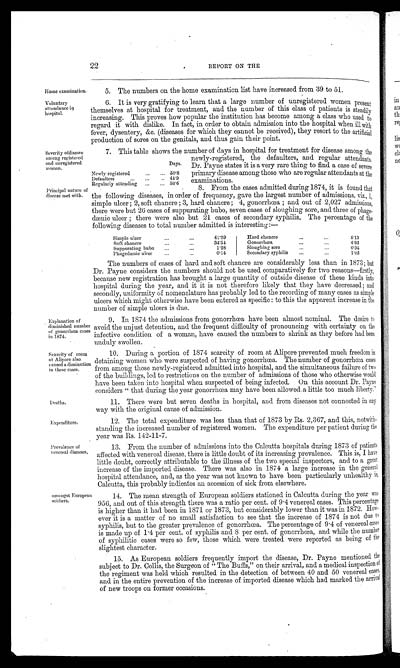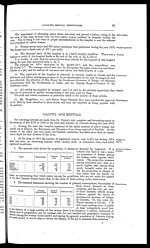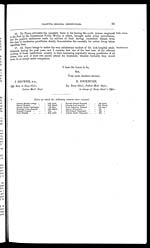Medicine - Institutions > Reports from medical colleges, schools and research institutions > Report on the Calcutta medical institutions > Calcutta medical institutions reports 1871-78 > Report on the Calcutta Medical Institutions for the year 1874
(451) Page 22
Download files
Individual page:
Thumbnail gallery: Grid view | List view

22
REPORT ON THE
Home examination.
5. The numbers on the home examination list have increased from 39 to 51.
Voluntary
attendance in
hospital.
6. It is very gratifying to learn that a large number of unregistered women present
themselves at hospital for treatment, and the number of this class of patients is steadily
increasing. This proves how popular the institution has become among a class who used to
regard it with dislike. In fact, in order to obtain admission into the hospital when ill with
fever, dysentery, &c. (diseases for which they cannot be received), they resort to the artificial
production of sores on the genitals, and thus gain their point.
Severity of disease
among registered
and unregistered
women.
| Days. | |
| Newly registered | 50.8 |
| Defaulters | 44.9 |
| Regularly attending | 36.6 |
7. This table shows the number of days in hospital for treatment for disease among the
newly-registered, the defaulters, and regular attendants.
Dr. Payne states it is a very rare thing to find a case of severe
primary disease among those who are regular attendants at the
examinations.
Principal nature of
disease met with.
8. From the cases admitted during 1874, it is found that
the following diseases, in order of frequency, gave the largest number of admissions, viz., 1,
simple ulcer; 2, soft chancre; 3, hard chancre; 4, gonorrhœa; and out of 2,027 admissions,
there were but 26 cases of suppurating bubo, seven cases of sloughing sore, and three of phage-
dæonic ulcer; there were also but 21 cases of secondary syphilis. The percentage of the
following diseases to total number admitted is interesting:—
| Simple ulcer | 41.39 |
| Soft chancre | 34.54 |
| Supporating bubo | 1.28 |
| Phagedænic ulcer | 0.14 |
| Hard chancre | 5.13 |
| Gonorrhœa | 4.93 |
| Sloughing sore | 0.34 |
| Secondary syphilis | 1.03 |
The numbers of cases of hard and soft chancre are considerably less than in 1873; but
Dr. Payne considers the numbers should not be used comparatively for two reasons—firstly,
because new registration has brought a large quantity of outside disease of these kinds into
hospital during the year, and it it is not therefore likely that they have decreased; and
secondly, uniformity of nomenclature has probably led to the recording of many cases as simple
ulcers which might otherwise have been entered as specific: to this the apparent increase in the
number of simple ulcers is due.
Explanation of
diminished number
of gonorrhœa cases
in 1874.
9. In 1874 the admissions from gonorrhœa have been almost nominal. The desire to
avoid the unjust detention, and the frequent difficulty of pronouncing with certainty on the
infective condition of a woman, have caused the numbers to shrink as they before had been
unduly swollen.
Scarcity of room
at Alipore also
caused a diminution
in these cases.
10. During a portion of 1874 scarcity of room at Alipore prevented much freedom in
detaining women who were suspected of having gonorrhœa. The number of gonorrhœa cases
from among those newly-registered admitted into hospital, and the simultaneous failure of two
of the buildings, led to restrictions on the number of admissions of those who otherwise would
have been taken into hospital when suspected of being infected. On this account Dr. Payne
considers "that during the year gonorrhœa may have been allowed a little too much liberty."
Deaths.
11. There were but seven deaths in hospital, and from diseases not connected in any
way with the original cause of admission.
Expenditure.
12. The total expenditure was less than that of 1873 by Rs. 2,367, and this, notwith-
standing the increased number of registered women. The expenditure per patient during the
year was Rs. 142-11-7.
Prevalence of
venereal diseases,
13. From the number of admissions into the Calcutta hospitals during 1873 of patients
affected with venereal disease, there is little doubt of its increasing prevalence. This is, I have
little doubt, correctly attributable to the illness of the two special inspectors, and to a great
increase of the imported disease. There was also in 1874 a large increase in the general
hospital attendance, and, as the year was not known to have been particularly unhealthy in
Calcutta, this probably indicates an accession of sick from elsewhere.
amongst European
soldiers.
14. The mean strength of European soldiers stationed in Calcutta during the year was
956, and out of this strength there was a ratio per cent. of 9.4 venereal cases. This percentage
is higher than it had been in 1871 or 1873, but considerably lower than it was in 1872. How-
ever it is a matter of no small satisfaction to see that the increase of 1874 is not due to
syphilis, but to the greater prevalence of gonorrhœa. The percentage of 9.4 of venereal cases
is made up of 1.4 per cent. of syphilis and 8 per cent. of gonorrhœa, and while the number
of syphilitic cases were so few, those which were treated were reported as being of the
slightest character.
15. As European soldiers frequently import the disease, Dr. Payne mentioned the
subject to Dr. Collis, the Surgeon of "The Buffs," on their arrival, and a medical inspection of
the regiment was held which resulted in the detection of between 40 and 50 venereal cases,
and in the entire prevention of the increase of imported disease which had marked the arrival
of new troops on former occasions.
Set display mode to: Large image | Zoom image | Transcription
Images and transcriptions on this page, including medium image downloads, may be used under the Creative Commons Attribution 4.0 International Licence unless otherwise stated. ![]()
| Permanent URL | https://digital.nls.uk/74974241 |
|---|
| Description | 13 titles. Describes research work and conditions, treatments, vaccine production, medical education, public health and disease outbreaks. Extensive tables show mortality rates and patient admissions. These - some from asylums, jails, dispensaries, civil and police hospitals – will be useful to epidemiologists. |
|---|




